A Crystal Mush Perspective Explains Magma Variability at La Fossa Volcano (Vulcano, Italy)
Abstract
:1. Introduction
2. Geological Background and Stratigraphy of the Last 1000 Years
3. Chemical and Petrographic Features of the Eruptive Products
4. The Plumbing System of La Fossa: Crystallization Conditions and Magma Differentiation
5. Geochemical Modelling
5.1. Thermodynamic Constraints on Magma Differentiation
5.2. Trace Element Geochemical Modelling
6. Discussion
6.1. Divergence between Natural Trends and Geochemical Models
6.2. Combined Mush Crystallization-Melt Extraction Modelling
6.3. The Crystal Mush Factory: A Petrologic Model for Intermediate Magmas
7. Conclusions
Supplementary Materials
Author Contributions
Funding
Data Availability Statement
Acknowledgments
Conflicts of Interest
References
- Sparks, R.S.J.; Cashman, K.V. Dynamic magma systems: Implications for forecasting volcanic activity. Elements 2017, 13, 35–40. [Google Scholar] [CrossRef]
- Edmonds, M.; Cashman, K.V.; Holness, M.; Jackson, M. Architecture and dynamics of magma reservoirs. Philos. Trans. R. Soc. 2019, 377, 20180298. [Google Scholar] [CrossRef]
- Cooper, K.M.; Kent, A.J. Rapid remobilization of magmatic crystals kept in cold storage. Nature 2014, 506, 480–483. [Google Scholar] [CrossRef]
- Huang, H.H.; Lin, F.C.; Schmandt, B.; Farrell, J.; Smith, R.B.; Tsai, V.C. The Yellowstone magmatic system from the mantle plume to the upper crust. Science 2015, 348, 773–776. [Google Scholar] [CrossRef] [Green Version]
- Cashman, K.V.; Sparks, R.S.J.; Blundy, J.D. Vertically extensive and unstable magmatic systems: A unified view of igneous processes. Science 2017, 355. [Google Scholar] [CrossRef] [Green Version]
- Sparks, R.S.J.; Annen, C.; Blundy, J.D.; Cashman, K.V.; Rust, A.C.; Jackson, M.D. Formation and dynamics of magma reservoirs. Philos. Trans. R. Soc. 2019, 377, 20180019. [Google Scholar] [CrossRef] [Green Version]
- Bachmann, O.; Bergantz, G.W. Gas percolation in upper-crustal silicic crystal mushes as a mechanism for upward heat advection and rejuvenation of near-solidus magma bodies. J. Volcanol. Geotherm. Res. 2006, 149, 85–102. [Google Scholar] [CrossRef]
- Bachmann, O.; Bergantz, G.W. On the origin of crystal-poor rhyolites: Extracted from batholithic crystal mushes. J. Petrol. 2004, 45, 1565–1582. [Google Scholar] [CrossRef]
- Bachmann, O.; Bergantz, G.W. Rhyolites and their source mushes across tectonic settings. J. Petrol. 2008, 49, 2277–2285. [Google Scholar] [CrossRef] [Green Version]
- Marsh, B.D. On bimodal differentiation by solidification front instability in basaltic magmas, part 1: Basic mechanics. Geochim. Cosmochim. Acta 2002, 66, 2211–2229. [Google Scholar] [CrossRef]
- Masotta, M.; Freda, C.; Gaeta, M. Origin of crystal-poor, differentiated magmas: Insights from thermal gradient experiments. Contrib. Miner. Petrol. 2012, 163, 49–65. [Google Scholar] [CrossRef]
- Masotta, M.; Mollo, S.; Gaeta, M.; Freda, C. Melt extraction in mush zones: The case of crystal-rich enclaves at the Sabatini Volcanic District (central Italy). Lithos 2016, 248, 288–292. [Google Scholar] [CrossRef]
- Pistone, M.; Arzilli, F.; Dobson, K.J.; Cordonnier, B.; Reusser, E.; Ulmer, P.; Blundy, J.D. Gas-driven filter pressing in magmas: Insights into in-situ melt segregation from crystal mushes. Geology 2015, 43, 699–702. [Google Scholar] [CrossRef]
- Dufek, J.; Bachmann, O. Quantum magmatism: Magmatic compositional gaps generated by melt-crystal dynamics. Geology 2010, 38, 687–690. [Google Scholar] [CrossRef]
- Gelman, S.E.; Deering, C.D.; Bachmann, O.; Huber, C.; Gutierrez, F.J. Identifying the crystal graveyards remaining after large silicic eruptions. Earth Planet. Sci. Lett. 2014, 403, 299–306. [Google Scholar] [CrossRef]
- Bachmann, O.; Deering, C.D.; Lipman, P.W.; Plummer, C. Building zoned ignimbrites by recycling silicic cumulates: Insight from the 1000 km3 Carpenter Ridge Tuff, CO. Contrib. Miner. Petrol. 2014, 167, 1025. [Google Scholar] [CrossRef] [Green Version]
- Ellis, B.S.; Bachmann, O.; Wolff, J.A. Cumulate fragments in silicic ignimbrites: The case of the Snake River Plain. Geology 2014, 42, 431–434. [Google Scholar] [CrossRef]
- Wolff, J.A.; Ellis, B.S.; Ramos, F.C.; Starkel, W.A.; Boroughs, S.; Olin, P.H.; Bachmann, O. Remelting of cumulates as a process for producing chemical zoning in silicic tuffs: A comparison of cool, wet and hot, dry rhyolitic magma systems. Lithos 2015, 236, 275–286. [Google Scholar] [CrossRef]
- Del Moro, A.; Gioncada, A.; Pinarelli, L.; Sbrana, A.; Joron, J.L. Sr, Nd, and Pb isotope evidence for open system evolution at Vulcano, Aeolian Arc, Italy. Lithos 1998, 43, 81–106. [Google Scholar] [CrossRef]
- De Astis, G.; Lucchi, F.; Dellino, P.; La Volpe, L.; Tranne, C.A.; Frezzotti, M.L.; Peccerillo, A. Geology, volcanic history and petrology of Vulcano (central Aeolian archipelago). Geol. Soc. Lond. Mem. 2013, 37, 281–349. [Google Scholar] [CrossRef]
- Costa, S.; Masotta, M.; Gioncada, A.; Pistolesi, M.; Bosch, D.; Scarlato, P. Magma evolution at La Fossa volcano (Vulcano Island, Italy) in the last 1000 years: Evidence from eruptive products and temperature gradient experiments. Contrib. Miner. Petrol. 2020, 175, 1–22. [Google Scholar] [CrossRef]
- Clocchiatti, R.; Del Moro, A.; Gioncada, A.; Joron, J.L.; Mosbah, M.; Pinarelli, L.; Sbrana, A. Assessment of a shallow magmatic system: The 1888–90 eruption, Vulcano Island, Italy. Bull. Volcanol. 1994, 56, 466–486. [Google Scholar] [CrossRef]
- Piochi, M.; De Astis, G.; Petrelli, M.; Ventura, G.; Sulpizio, R.; Zanetti, A. Constraining the recent plumbing system of Vulcano (Aeolian Arc, Italy) by textural, petrological, and fractal analysis: The 1739 AD Pietre Cotte lava flow. Geochem. Geophy. Geosyst. 2009, 10. [Google Scholar] [CrossRef]
- Perugini, D.; Valentini, L.; Poli, G. Insights into magma chamber processes from the analysis of size distribution of enclaves in lava flows: A case study from Vulcano Island (Southern Italy). J. Volcanol. Geotherm. Res. 2007, 166, 193–203. [Google Scholar] [CrossRef]
- Vetere, F.; Petrelli, M.; Morgavi, D.; Perugini, D. Dynamics and time evolution of a shallow plumbing system: The 1739 and 1888–90 eruptions, Vulcano Island, Italy. J. Volcanol. Geotherm. Res. 2015, 306, 74–82. [Google Scholar] [CrossRef]
- Forni, F.; Ellis, B.S.; Bachmann, O.; Lucchi, F.; Tranne, C.A.; Agostini, S.; Dallai, L. Erupted cumulate fragments in rhyolites from Lipari (Aeolian Islands). Contrib. Miner. Petrol. 2015, 170, 49. [Google Scholar] [CrossRef]
- Bullock, L.A.; Gertisser, R.; O’Driscoll, B.; Harland, S. Magmatic evolution and textural development of the 1739 CE Pietre Cotte lava flow, Vulcano, Italy. J. Volcanol. Geotherm. Res. 2019, 372, 1–23. [Google Scholar] [CrossRef] [Green Version]
- Di Traglia, F.; Pistolesi, M.; Rosi, M.; Bonadonna, C.; Fusillo, R.; Roverato, M. Growth and erosion: The volcanic geology and morphological evolution of La Fossa (Island of Vulcano, Southern Italy) in the last 1000 years. Geomorphology 2013, 194, 94–107. [Google Scholar] [CrossRef]
- Fulignati, P.; Gioncada, A.; Costa, S.; Di Genova, D.; Di Traglia, F.; Pistolesi, M. Magmatic sulfide immiscibility at an active magmatic-hydrothermal system: The case of La Fossa (Vulcano, Italy). J. Volcanol. Geotherm. Res. 2018, 358, 45–57. [Google Scholar] [CrossRef]
- De Astis, G.; Peccerillo, A.; Kempton, P.D.; La Volpe, L.; Wu, T.W. Calcalkaline to potassium-rich magmatism in the Aeolian Arc: Geochemical and Sr, Nd, Pb isotopic constraints from the Island of Vulcano (Aeolian arc). Contrib. Miner. Petrol. 2000, 139, 684–703. [Google Scholar] [CrossRef]
- Casalbore, D.; Romagnoli, C.; Bosman, A.; De Astis, G.; Lucchi, F.; Tranne, C.A.; Chiocci, F.L. Multi-stage formation of La Fossa Caldera (Vulcano Island, Italy) from an integrated subaerial and submarine analysis. Mar. Geophys. Res. 2019, 40, 479–492. [Google Scholar] [CrossRef]
- Frazzetta, G.; La Volpe, L.; Sheridan, M.F. Evolution of the Fossa cone, Vulcano. J. Volcanol. Geotherm. Res. 1983, 17, 329–360. [Google Scholar] [CrossRef]
- Arrighi, S.; Tanguy, J.C.; Rosi, M. Eruptions of the last 2200 years at Vulcano and Vulcanello (Aeolian Islands, Italy) dated by high-accuracy archeomagnetism. Phys. Earth Planet. Interior 2006, 159, 225–233. [Google Scholar] [CrossRef]
- Selva, J.; Bonadonna, C.; Branca, S.; De Astis, G.; Gambino, S.; Paonita, A.; Pistolesi, M.; Ricci, T.; Sulpizio, R.; Tibaldi, A.; et al. Multiple hazards and paths to eruptions: A review of the volcanic system of Vulcano (Aeolian Islands, Italy). Earth-Sci. Rev. 2020, 207, 103186. [Google Scholar] [CrossRef]
- Davì, M.; De Rosa, R.; Donato, P.; Vetere, F.; Barca, D.; Cavallo, A. Magmatic Evolution and plumbing system of ring-fault volcanism: The Vulcanello Peninsula (Aeolian Islands, Italy). Eur. J. Mineral. 2009, 21, 1009–1028. [Google Scholar] [CrossRef]
- Fusillo, R.; Di Traglia, F.; Gioncada, A.; Pistolesi, M.; Wallace, P.J.; Rosi, M. Deciphering post-caldera volcanism: Insight into the Vulcanello (Island of Vulcano, Southern Italy) eruptive activity based on geological and petrological constraints. Bull. Volcanol. 2015, 77, 76. [Google Scholar] [CrossRef]
- Nicotra, E.; Giuffrida, M.; Viccaro, M.; Donato, P.; D’Oriano, C.; Paonita, A.; De Rosa, R. Timescales of pre-eruptive magmatic processes at Vulcano (Aeolian Islands, Italy) during the last 1000 years. Lithos 2018, 316, 347–365. [Google Scholar] [CrossRef]
- Pinarelli, L.; Gioncada, A.; Capaccioni, B.; Vaselli, O.; Downes, H. Mantle source heterogeneity in subduction zones: Constraints from elemental and isotope (Sr, Nd, and Pb) data on Vulcano Island, Aeolian Archipelago, Italy. Miner. Petrol. 2019, 113, 39–60. [Google Scholar] [CrossRef]
- Gioncada, A. L’attività Eruttiva Degli Ultimi 50,000 Anni di Vulcano (Eolie): Aspetti Vulcanologici e Magmatologici. Ph.D. Thesis, University of Pisa, Pisa, Italy, 1997. [Google Scholar]
- Costa, S. The Active Plumbing System of La Fossa (Vulcano, Italy): Clues to Mafic-Silicic Magma Interactions and the Link with the Magmatic-Hydrothermal Environment. Ph.D. Thesis, University of Florence, Florence, Italy, 2021. [Google Scholar]
- Costa, S.; Fulignati, P.; Campbell, I.H.; Gioncada, A.; Carrasco Godoy, C.I.; Pistolesi, M.; Masotta, M. Platinum-group element geochemistry of the shoshonitic igneous suite of Vulcano (Aeolian Arc, Italy): Implications for chalcophile element fertility of arc magmas. Contrib. Miner. Petrol. under review.
- Rossi, S.; Petrelli, M.; Morgavi, D.; Vetere, F.; Almeev, R.R.; Astbury, R.L.; Perugini, D. Role of magma mixing in the pre-eruptive dynamics of the Aeolian Islands volcanoes (Southern Tyrrhenian Sea, Italy). Lithos 2019, 324, 165–179. [Google Scholar] [CrossRef]
- De Fino, M.; La Volpe, L.; Piccarreta, G. Role of magma mixing during the recent activity of La Fossa di Vulcano (Aeolian Islands, Italy). J. Volcanol. Geotherm. Res. 1991, 48, 385–398. [Google Scholar] [CrossRef]
- Zanon, V.; Frezzotti, M.L.; Peccerillo, A. Magmatic feeding system and crustal magma accumulation beneath Vulcano Island (Italy): Evidence from CO2 fluid inclusions in quartz xenoliths. J. Geophys. Res. Sol. Earth 2003, 108. [Google Scholar] [CrossRef]
- Masotta, M.; Mollo, S. A new plagioclase-liquid hygrometer specific to trachytic systems. Minerals 2019, 9, 375. [Google Scholar] [CrossRef] [Green Version]
- Gioncada, A.; Clocchiatti, R.; Sbrana, A.; Bottazzi, P.; Massare, D.; Ottolini, L. A study of melt inclusions at Vulcano (Aeolian Islands, Italy): Insights on the primitive magmas and on the volcanic feeding system. Bull. Volcanol. 1998, 60, 286–306. [Google Scholar] [CrossRef]
- Peccerillo, A.; Frezzotti, M.L.; De Astis, G.; Ventura, G. Modeling the magma plumbing system of Vulcano (Aeolian Islands, Italy) by integrated fluid-inclusion geobarometry, petrology, and geophysics. Geology 2006, 34, 17–20. [Google Scholar] [CrossRef]
- De Astis, G.; La Volpe, L.; Peccerillo, A.; Civetta, L. Volcanological and petrological evolution of Vulcano island (Aeolian Arc, southern Tyrrhenian Sea). J. Geophys. Res. Sol. Earth 1997, 102, 8021–8050. [Google Scholar] [CrossRef]
- Frezzotti, M.L.; Peccerillo, A.; Zanon, V.; Nikogosian, I. Silica-rich melts in quartz xenoliths from Vulcano Island and their bearing on processes of crustal anatexis and crust–magma interaction beneath the Aeolian Arc, Southern Italy. J. Petrol. 2004, 45, 3–26. [Google Scholar] [CrossRef] [Green Version]
- Mandarano, M.; Paonita, A.; Martelli, M.; Viccaro, M.; Nicotra, E.; Millar, I.L. Revealing magma degassing below closed-conduit active volcanoes: Geochemical features of volcanic rocks versus fumarolic fluids at Vulcano (Aeolian Islands, Italy). Lithos 2016, 248, 272–287. [Google Scholar] [CrossRef]
- Paonita, A.; Federico, C.; Bonfanti, P.; Capasso, G.; Inguaggiato, S.; Italiano, F.; Sortino, F. The episodic and abrupt geochemical changes at La Fossa fumaroles (Vulcano Island, Italy) and related constraints on the dynamics, structure, and compositions of the magmatic system. Geochim. Cosmochim. Acta 2013, 120, 158–178. [Google Scholar] [CrossRef]
- Gualda, G.A.; Ghiorso, M.S.; Lemons, R.V.; Carley, T.L. Rhyolite-MELTS: A modified calibration of MELTS optimized for silica-rich, fluid-bearing magmatic systems. J. Petrol. 2012, 53, 875–890. [Google Scholar] [CrossRef] [Green Version]
- Ghiorso, M.S.; Gualda, G.A. An H2O–CO2 mixed fluid saturation model compatible with rhyolite-MELTS. Contrib. Miner. Petrol. 2015, 169, 1–30. [Google Scholar] [CrossRef]
- Bohrson, W.A.; Spera, F.J.; Ghiorso, M.S.; Brown, G.A.; Creamer, J.B.; Mayfield, A. Thermodynamic model for energy-constrained open-system evolution of crustal magma bodies undergoing simultaneous recharge, assimilation and crystallization: The magma chamber simulator. J. Petrol. 2014, 55, 1685–1717. [Google Scholar] [CrossRef] [Green Version]
- Bohrson, W.A.; Spera, F.J.; Heinonen, J.S.; Brown, G.A.; Scruggs, M.A.; Adams, J.V.; Takach, M.K.; Zeff, G.; Suikkanen, E. Diagnosing open-system magmatic processes using the Magma Chamber Simulator (MCS): Part I—major elements and phase equilibria. Contrib. Miner. Petrol. 2020, 175, 1–29. [Google Scholar] [CrossRef]
- DePaolo, D.J. Trace element and isotopic effects of combined wallrock assimilation and fractional crystallization. Earth Planet. Sci. Lett. 1981, 53, 189–202. [Google Scholar] [CrossRef]
- Heinonen, J.S.; Bohrson, W.A.; Spera, F.J.; Brown, G.A.; Scruggs, M.A.; Adams, J.V. Diagnosing open-system magmatic processes using the Magma Chamber Simulator (MCS): Part II—trace elements and isotopes. Contrib. Miner. Petrol. 2020, 175, 1–21. [Google Scholar] [CrossRef]
- Palummo, F.; Mollo, S.; De Astis, G.; Di Stefano, F.; Nazzari, M.; Scarlato, P. Petrological and geochemical modeling of magmas erupted at Vulcano Island in the period 54–8 ka: Quantitative constraints on the sub-volcanic architecture of the plumbing system. Lithos 2020, 374, 105715. [Google Scholar] [CrossRef]
- Frazzetta, G.; La Volpe, L. Volcanic history and maximum expected eruption at “La Fossa di Vulcano” (Aeolian Islands, Italy). Acta Vulcanol. 1991, 1, 107–113. [Google Scholar]
- Deering, C.D.; Cole, J.W.; Vogel, T.A. Extraction of crystal-poor rhyolite from a hornblende-bearing intermediate mush: A case study of the caldera-forming Matahina eruption, Okataina volcanic complex. Contrib. Miner. Petrol. 2011, 161, 129–151. [Google Scholar] [CrossRef]
- Zou, B.; Ma, C. Crystal mush rejuvenation induced by heat and water transfer: Evidence from amphibole analyses in the Jialuhe Composite Pluton, East Kunlun Orogen, northern Tibet Plateau. Lithos 2020, 376, 105722. [Google Scholar] [CrossRef]
- Shaw, D.M. Trace element fractionation during anatexis. Geochim. Cosmochim. Acta 1970, 34, 237–243. [Google Scholar] [CrossRef]
- Vetere, F.; Behrens, H.; Misiti, V.; Ventura, G.; Holtz, F.; De Rosa, R.; Deubener, J. The viscosity of shoshonitic melts (Vulcanello Peninsula, Aeolian Islands, Italy): Insight on the magma ascent in dikes. Chem. Geol. 2007, 245, 89–102. [Google Scholar] [CrossRef] [Green Version]
- Forni, F.; Degruyter, W.; Bachmann, O.; De Astis, G.; Mollo, S. Long-term magmatic evolution reveals the beginning of a new caldera cycle at Campi Flegrei. Sci. Adv. 2018, 4, eaat9401. [Google Scholar] [CrossRef] [Green Version]
- Forni, F.; Petricca, E.; Bachmann, O.; Mollo, S.; De Astis, G.; Piochi, M. The role of magma mixing/mingling and cumulate melting in the Neapolitan Yellow Tuff caldera-forming eruption (Campi Flegrei, Southern Italy). Contrib. Miner. Petrol. 2018, 173, 45. [Google Scholar] [CrossRef]
- Wolff, J.A.; Forni, F.; Ellis, B.S.; Szymanowski, D. Europium and barium enrichments in compositionally zoned felsic tuffs: A smoking gun for the origin of chemical and physical gradients by cumulate melting. Earth Planet. Sci. Lett. 2020, 540, 116251. [Google Scholar] [CrossRef]
- Villemant, B.; Jaffrezic, H.; Joron, J.L.; Treuil, M. Distribution coefficients of major and trace elements; fractional crystallization in the alkali basalt series of Chaine des Puys (Massif Central, France). Geochim. Cosmochim. Acta 1981, 45, 1997–2016. [Google Scholar] [CrossRef]
- Villemant, B. Trace element evolution in the Phlegrean Fields (Central Italy): Fractional crystallization and selective enrichment. Contrib. Miner. Petrol. 1988, 98, 169–183. [Google Scholar] [CrossRef]
- Blundy, J.D.; Wood, B.J. Crystal-chemical controls on the partitioning of Sr and Ba between plagioclase feldspar, silicate melts, and hydrothermal solutions. Geochim. Cosmochim. Acta 1991, 55, 193–209. [Google Scholar] [CrossRef]
- Ewart, A.; Griffin, W.L. Application of proton-microprobe data to trace-element partitioning in volcanic rocks. Chem. Geol. 1994, 117, 251–284. [Google Scholar] [CrossRef]
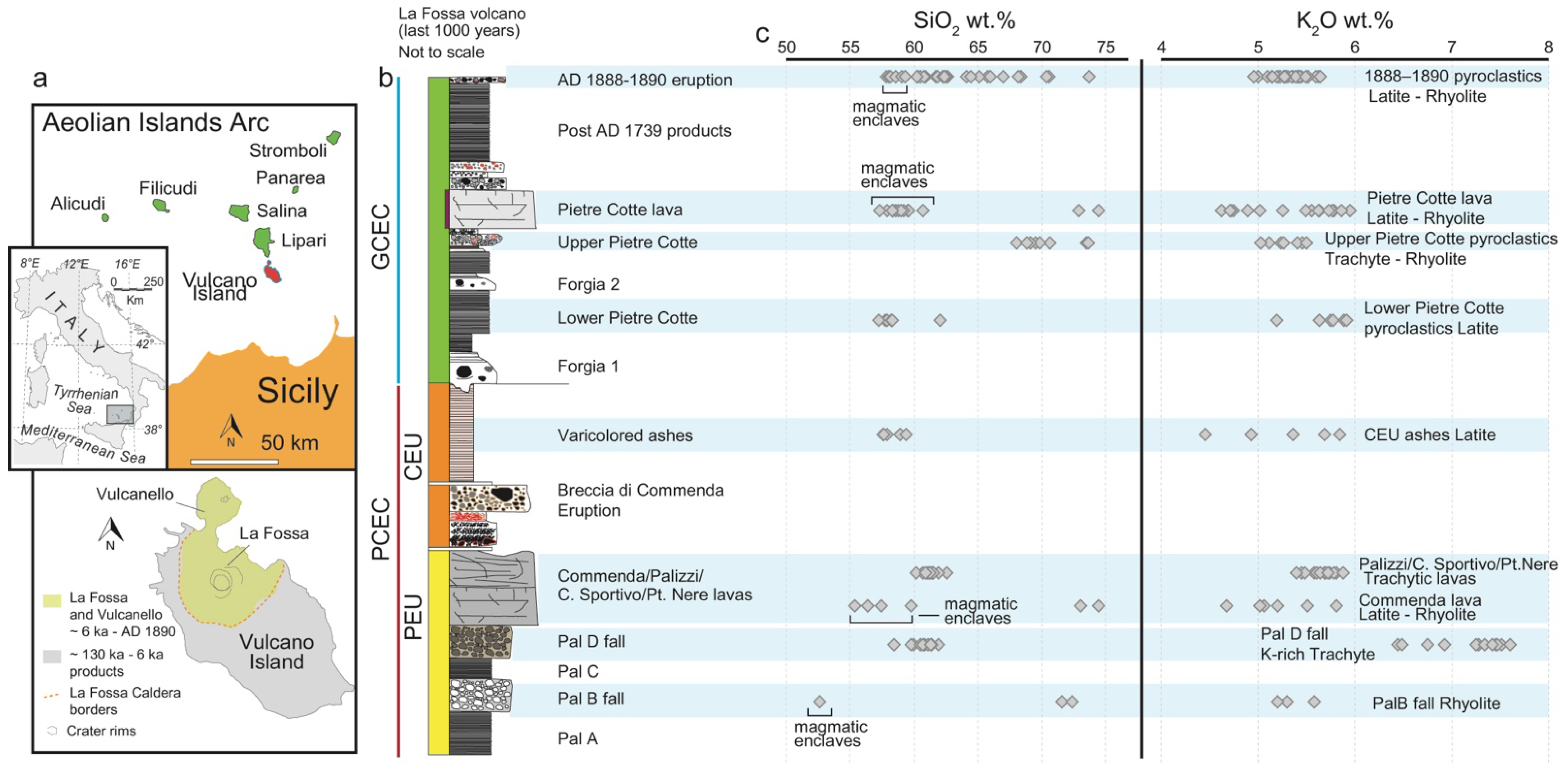

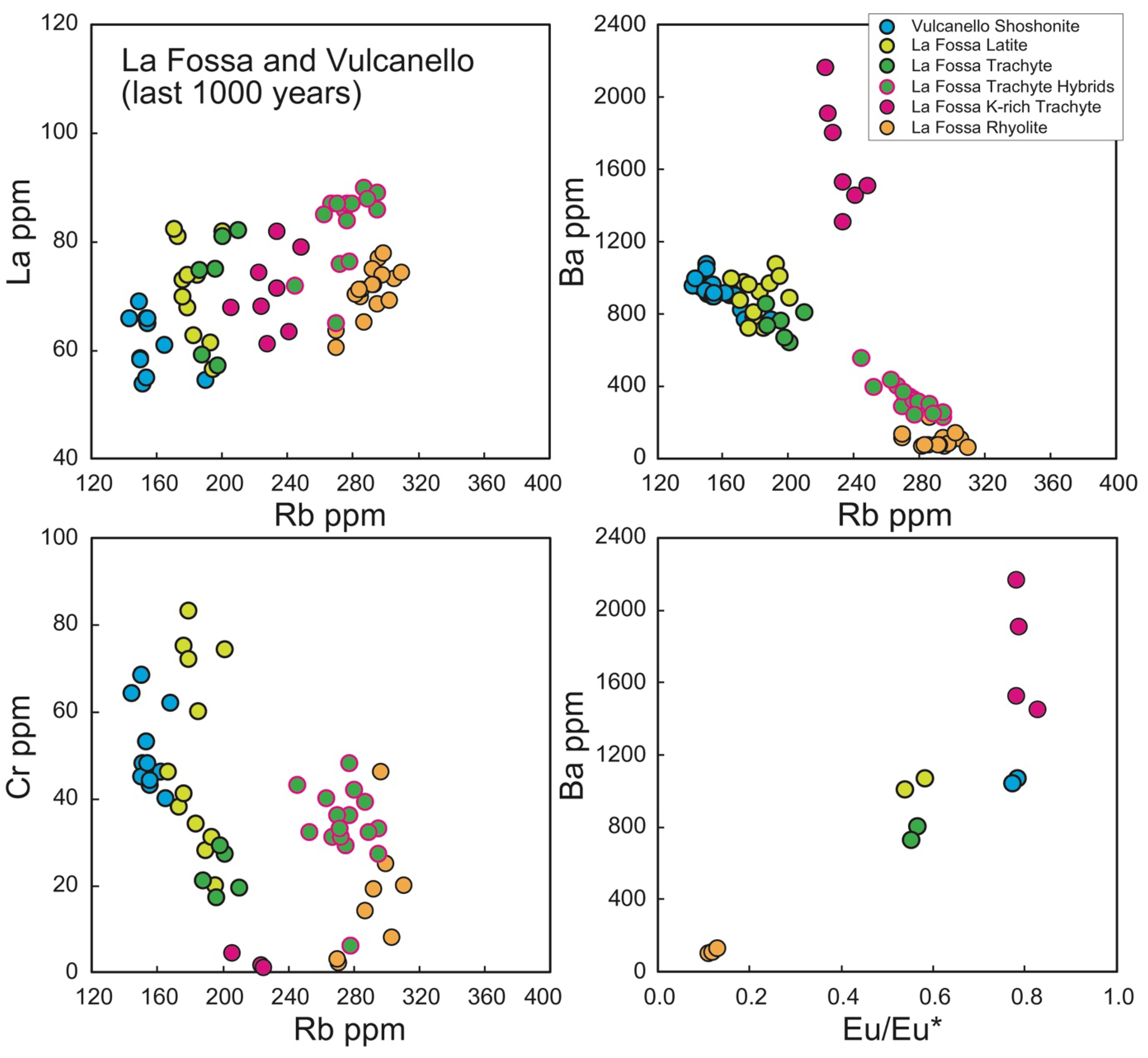

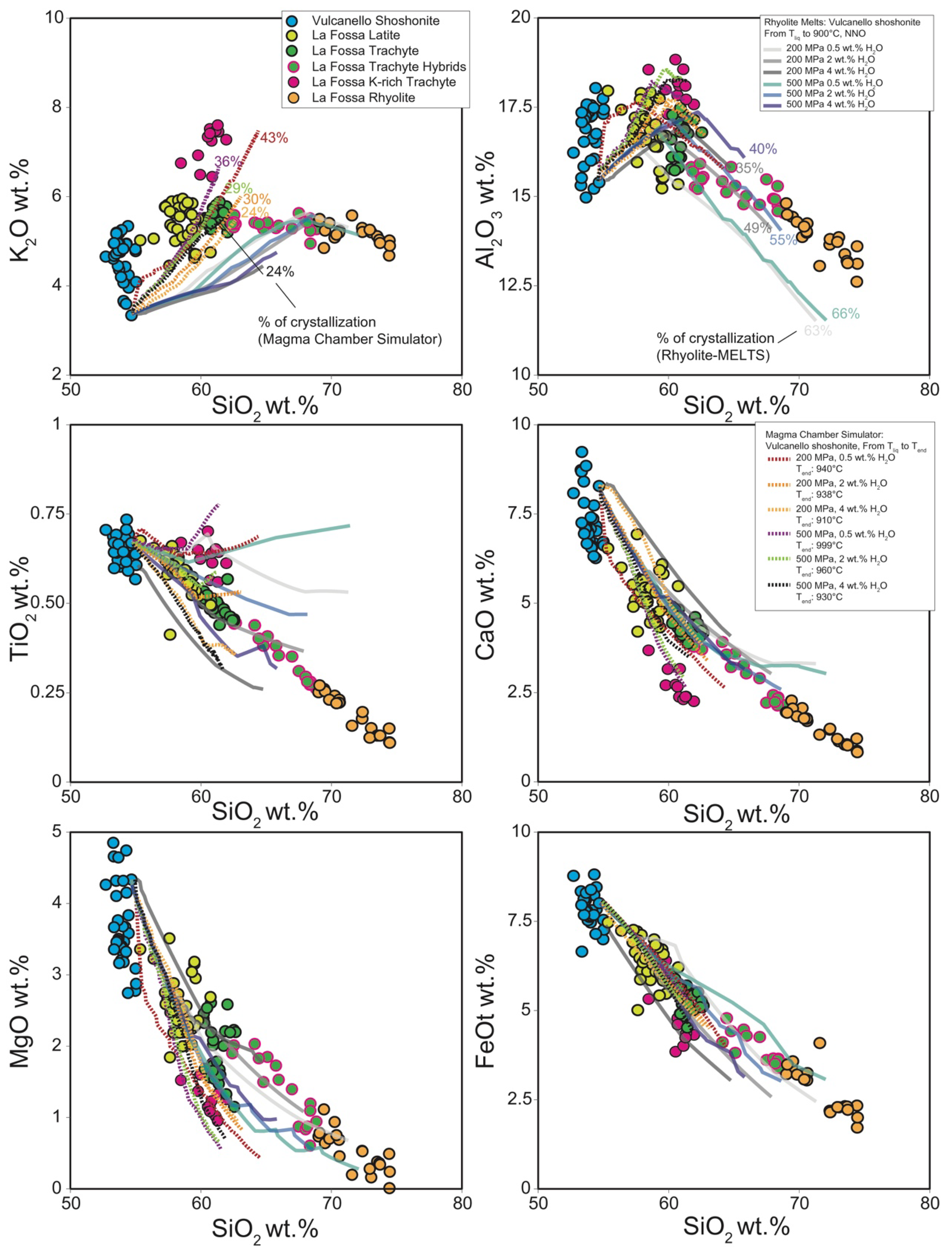
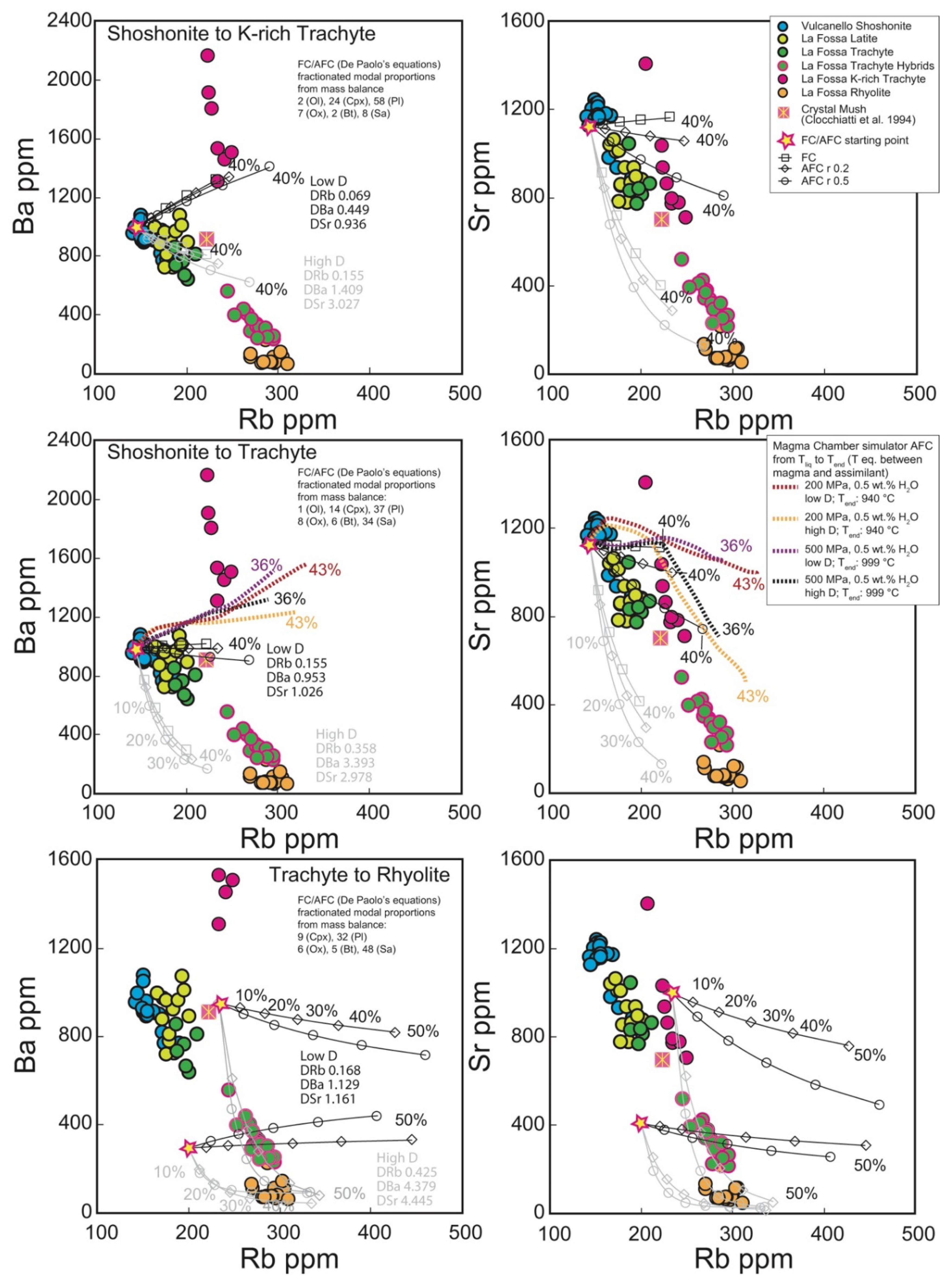
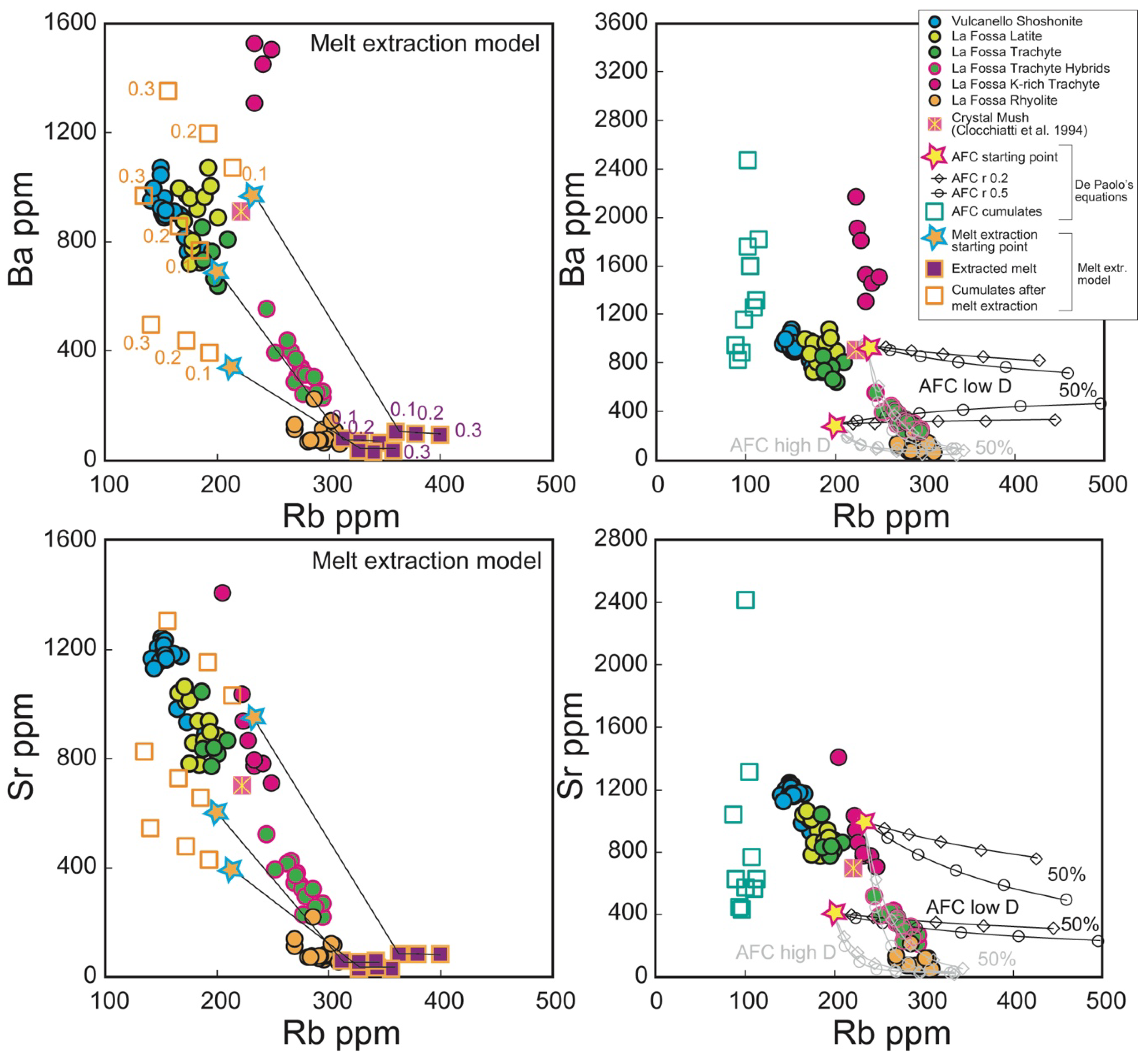
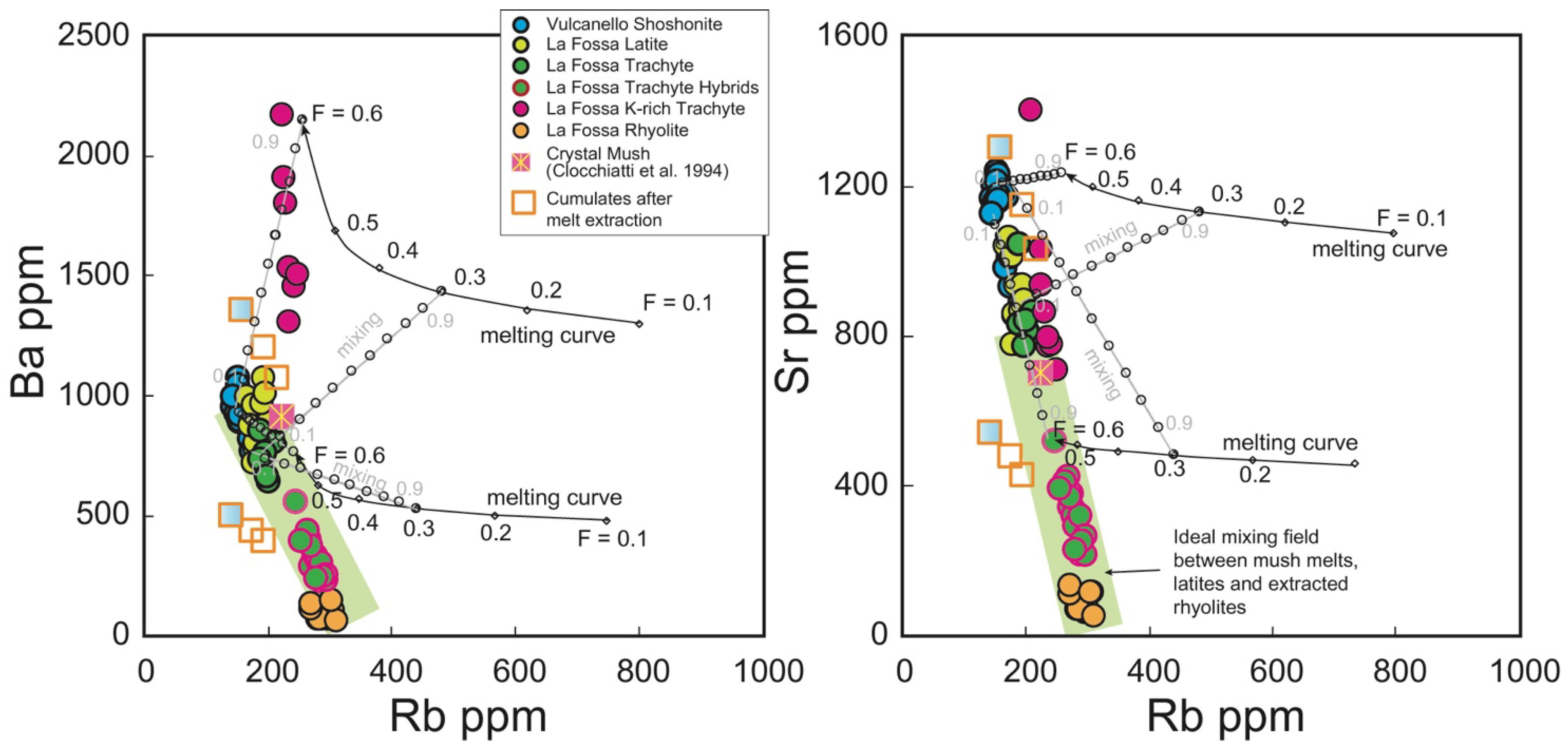
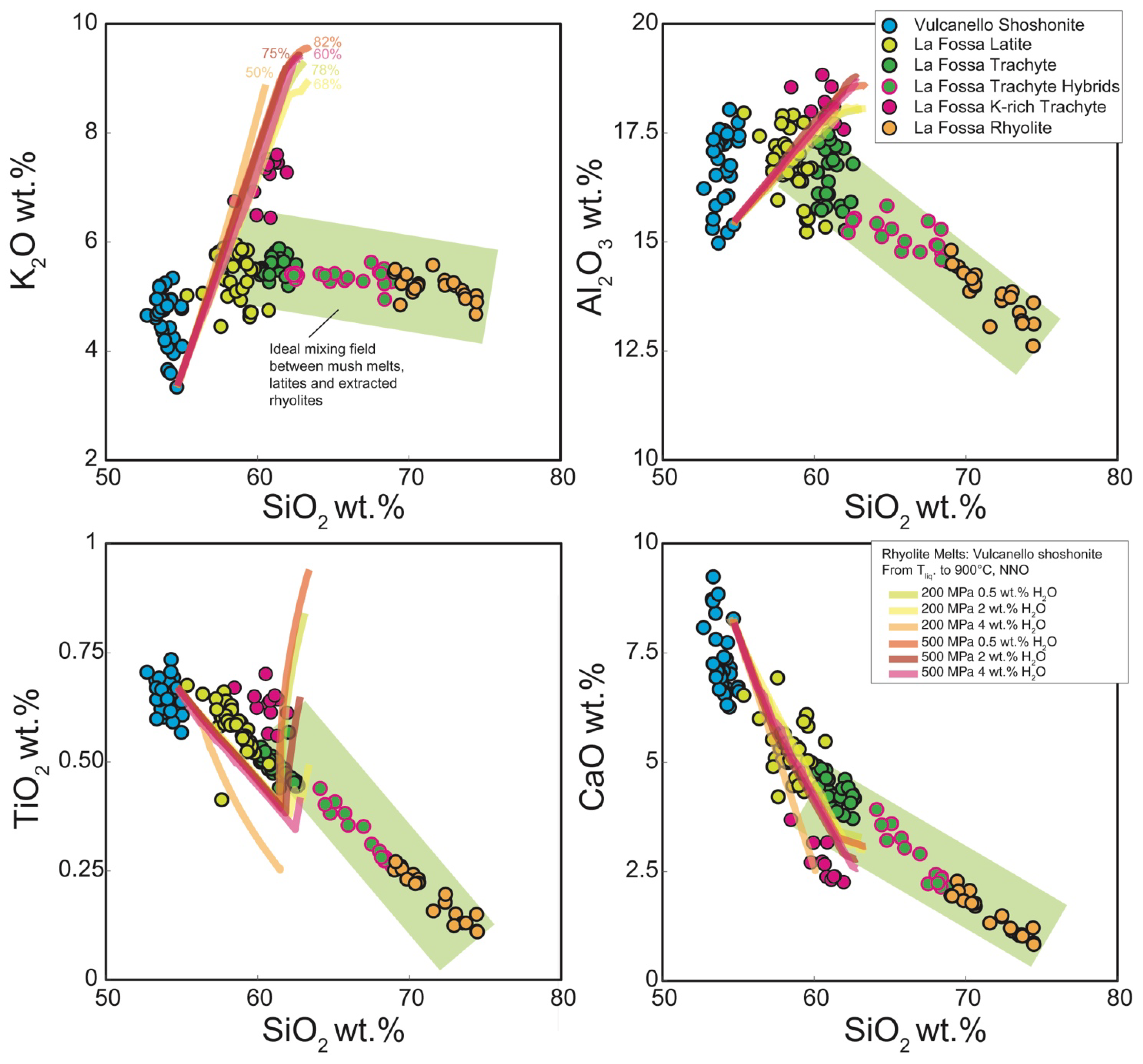
Publisher’s Note: MDPI stays neutral with regard to jurisdictional claims in published maps and institutional affiliations. |
© 2021 by the authors. Licensee MDPI, Basel, Switzerland. This article is an open access article distributed under the terms and conditions of the Creative Commons Attribution (CC BY) license (https://creativecommons.org/licenses/by/4.0/).
Share and Cite
Costa, S.; Masotta, M.; Gioncada, A.; Pistolesi, M. A Crystal Mush Perspective Explains Magma Variability at La Fossa Volcano (Vulcano, Italy). Minerals 2021, 11, 1094. https://doi.org/10.3390/min11101094
Costa S, Masotta M, Gioncada A, Pistolesi M. A Crystal Mush Perspective Explains Magma Variability at La Fossa Volcano (Vulcano, Italy). Minerals. 2021; 11(10):1094. https://doi.org/10.3390/min11101094
Chicago/Turabian StyleCosta, Simone, Matteo Masotta, Anna Gioncada, and Marco Pistolesi. 2021. "A Crystal Mush Perspective Explains Magma Variability at La Fossa Volcano (Vulcano, Italy)" Minerals 11, no. 10: 1094. https://doi.org/10.3390/min11101094
APA StyleCosta, S., Masotta, M., Gioncada, A., & Pistolesi, M. (2021). A Crystal Mush Perspective Explains Magma Variability at La Fossa Volcano (Vulcano, Italy). Minerals, 11(10), 1094. https://doi.org/10.3390/min11101094





